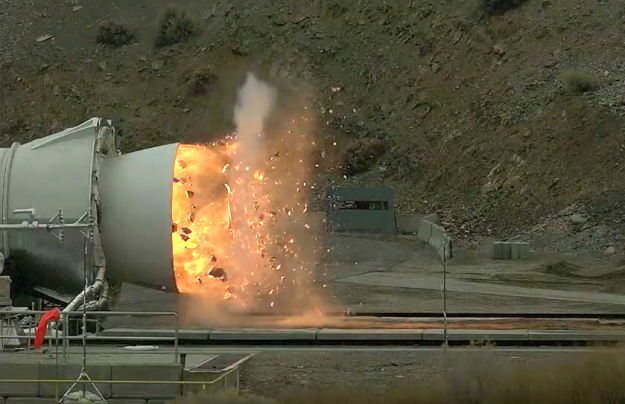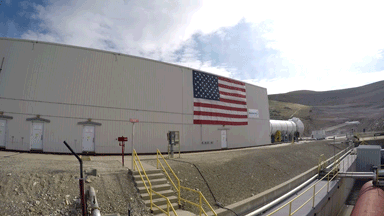By Beverly Perry
For two monumental minutes on June 28, the Space Launch System (SLS) solid rocket boosters — the largest ever built for flight — will fire up in an amazing display of power as engineers verify their designs in the last full-scale test before SLS’s first flight in late 2018. Each piece of hardware that’s qualified and each major test — like this one, dubbed QM-2 — puts NASA one step closer on its Journey to Mars.
The smoke and fire may last only two minutes, but engineers at NASA’s Marshall Space Flight Center in Huntsville, Alabama and Orbital ATK in Promontory, Utah have been preparing weeks — even months — in advance for the static test of Qualification Motor 2 (QM-2). Here’s a behind-the-scenes look at what goes into getting ready to fire up the largest and most powerful solid rocket motor ever built for flight.
T (for test) minus weeks and months. In the months prior to the test, propellant-filled segments began arriving at Orbital ATK’s Test Bay T-97 after being cast in nearby facilities. Many of these segments are veterans of space shuttle flights. In fact, the various metal case segments that comprise the five-segment QM-2 motor flew on 48 shuttle flights!
T minus 14 days. In the two weeks leading up to the test, Orbital ATK engineers begin dry runs that simulate the final test as closely as possible (without the smoke and fire). They put the motor and associated systems through their paces no fewer than 11 times before the big day to ensure not only that all systems are functioning as expected, but also that the test will be executed properly. “We only get one shot at firing the rocket motor,” says Dr. Janica Cheney, Orbital ATK’s director of Test Operations. “All the dry runs and other preparations that take place ahead of time are critical to ensuring we get the data we need from this test firing.”

T minus 24 hours. For this final full-scale static test, engineers have 82 goals, or test objectives, they need to measure and evaluate. One day before the test, it’s crunch time; caffeine’s flowing as engineers work around the clock the day before the test to ensure all systems function properly and all necessary data can be collected.
T minus 8 hours. Game day. There’s focus — and excitement. There are two more dry runs leading up to the test. Engineers, technicians and operators are “on station,” — present and accounted for at key locations such as the test bay, the instrument rooms and the control bunker. When you hear “control bunker,” think mission control — a command and control center that directs every aspect of the test, similar to what you see at mission control during a launch. Time flies during the final eight hours before the test.

T minus 6 hours. At 4:05 a.m. EDT (2:05 a.m. MDT), engineers and managers at Orbital ATK and NASA will make a “go” or “no go” decision on testing that day. Assuming the test’s a go, technicians “roll back” Orbital ATK’s specially designed moveable test bay housing and begin running final checks to make sure everything is ready. “We check the status of all the data and control systems, the test bay, the motor preparation and weather conditions,” Cheney says.
Weather is one variable that can halt the QM-2 test. “We make sure there’s no lightning in the area; no high winds; no storms,” explains Orbital ATK Fire Chief Blair Westergard. “We also establish fire breaks. Along with the Box Elder County Fire District, we’re prepared to extinguish any secondary wildfires too.”
Engineers also make sure cameras are ready to film and all data recording systems are online and functioning properly. Orbital ATK Security ensures the area around the test is clear.
T minus 3 hours. Crowds begin to gather as the public viewing area near Promontory off State Route 83 opens at 7:30 a.m. EDT (5:30 a.m. MDT). Orbital ATK Security directs traffic with the help of the Utah Highway Patrol and provides crowd control support to ensure everything remains orderly — vital when 10,000 people are in attendance.
https://www.youtube.com/watch?v=https://www.youtube.com/watch?v=c-xrhYKC0q4[/embedyt]
If you do not see the video above, please make sure the URL at the top of the page reads http, not https.
T minus 1 hour. The formal countdown commences; the public address system broadcast begins. The crew in the test bay begins final procedures to prepare the booster for testing.
T minus 9 minutes. Final system and timing checks are underway.
T minus 4 minutes. A “go for test” announcement sounds from the public address system.
T minus 1 minute. A siren begins; it will blare through T minus 20 seconds.
T minus 45 seconds. The “Safe and Arm” system sequence begins, which arms the motor. The Safe and Arm device is remotely activated from the “safe” position into the “armed” position, allowing the motor to ignite when the “fire” command is given.
T minus zero. At 10:05 a.m. EDT (8:05 MDT), two minutes of pure awesome commence as the gigantic motor burns through about five and a half tons of propellant each second during the approximately two-minute test. Inside the control bunker, there will be jubilation — and relief. “This is serious business — this is rocket science,” Cheney emphasizes. “But there’s nothing better than the smoke and fire and the data that comes with it when you’ve had a successful day. Our success is NASA’s success — we don’t do it alone.”
Join in the conversation: Visit our Facebook page to comment on the post about this blog. We’d love to hear your feedback!




